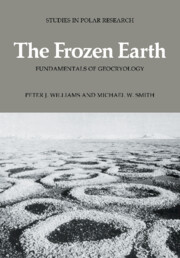Book contents
- Frontmatter
- Contents
- Symbols
- Preface
- Acknowledgements
- 1 PERIGLACIAL CONDITIONS
- 2 MORPHOLOGY OF PERMAFROST AND SEASONALLY FROZEN GROUND
- 3 CLIMATE AND FROZEN GROUND
- 4 THE GROUND THERMAL REGIME
- 5 THE FORMS OF THE GROUND SURFACE 1: SLOPES AND SUBSIDENCES
- 6 THE FORMS OF THE GROUND SURFACE 2: STRUCTURES AND MICROTOPOGRAPHY OF LEVEL GROUND
- 7 THERMODYNAMIC BEHAVIOUR OF FROZEN SOILS
- 8 HYDROLOGY OF FROZEN GROUND
- 9 THE MECHANICS OF FROZEN GROUND
- 10 GEOCRYOLOGY PAST AND FUTURE
- References
- Index
1 - PERIGLACIAL CONDITIONS
Published online by Cambridge University Press: 24 October 2009
- Frontmatter
- Contents
- Symbols
- Preface
- Acknowledgements
- 1 PERIGLACIAL CONDITIONS
- 2 MORPHOLOGY OF PERMAFROST AND SEASONALLY FROZEN GROUND
- 3 CLIMATE AND FROZEN GROUND
- 4 THE GROUND THERMAL REGIME
- 5 THE FORMS OF THE GROUND SURFACE 1: SLOPES AND SUBSIDENCES
- 6 THE FORMS OF THE GROUND SURFACE 2: STRUCTURES AND MICROTOPOGRAPHY OF LEVEL GROUND
- 7 THERMODYNAMIC BEHAVIOUR OF FROZEN SOILS
- 8 HYDROLOGY OF FROZEN GROUND
- 9 THE MECHANICS OF FROZEN GROUND
- 10 GEOCRYOLOGY PAST AND FUTURE
- References
- Index
Summary
The significance of freezing in soils and rocks
Water is ubiquitous in the surface regions of the earth, and is unique in the extent of its occurrence in all three phases: solid, liquid and gaseous. Its formative influence on the nature of the earth's surface, on the behaviour of earth materials, and its role in the complex pattern of transfers of energy and mass in the ground and atmosphere mean that water is a central component of study in the earth sciences. However, the solid phase, and transitions between solid and liquid or vapour, have in this context received relatively little attention. While the subject of glaciology has concerned itself with snow and ice, the study of freezing and thawing within soils and rocks has been more limited and mainly of recent date.
Water freezes at 0°C and in doing so expands by 9% of its volume. In freezing it may exert great expansive pressures. These statements serve for many everyday considerations. But they require qualification in that only pure water, under a pressure of one atmosphere, and in sufficient quantity, freezes at 0°C. Those conditions are generally not met when freezing occurs within soil or rock materials. This is not a matter of mere scientific pedantry, of trivial deviations of freezing point arising from the fact that natural waters are never pure in the ultimate sense, or from the fact that they are commonly subject to some gravitationally produced pressure arising from weight.
- Type
- Chapter
- Information
- The Frozen EarthFundamentals of Geocryology, pp. 1 - 26Publisher: Cambridge University PressPrint publication year: 1989



